antiAtlas Journal #01 - 2016
Arts, sciences
and exploratory procedures
Jean Cristofol
Jean Cristofol is Professor of Philosophy at the École Supérieure d'Art of Aix-en-Provence. He is member of the antiAtlas of Borders collective. His latest publication is: “Flux, stocks et Fuites”, in Locus Sonus, 10 ans d'expérimentations en art sonore, Éditions Le Mot et le Reste, 2015.
Translated by Caroline Mackenzie.
Keywords: arts/sciences, exploration, technique, medias, experience, experimentation, organs, apparatus, critique.
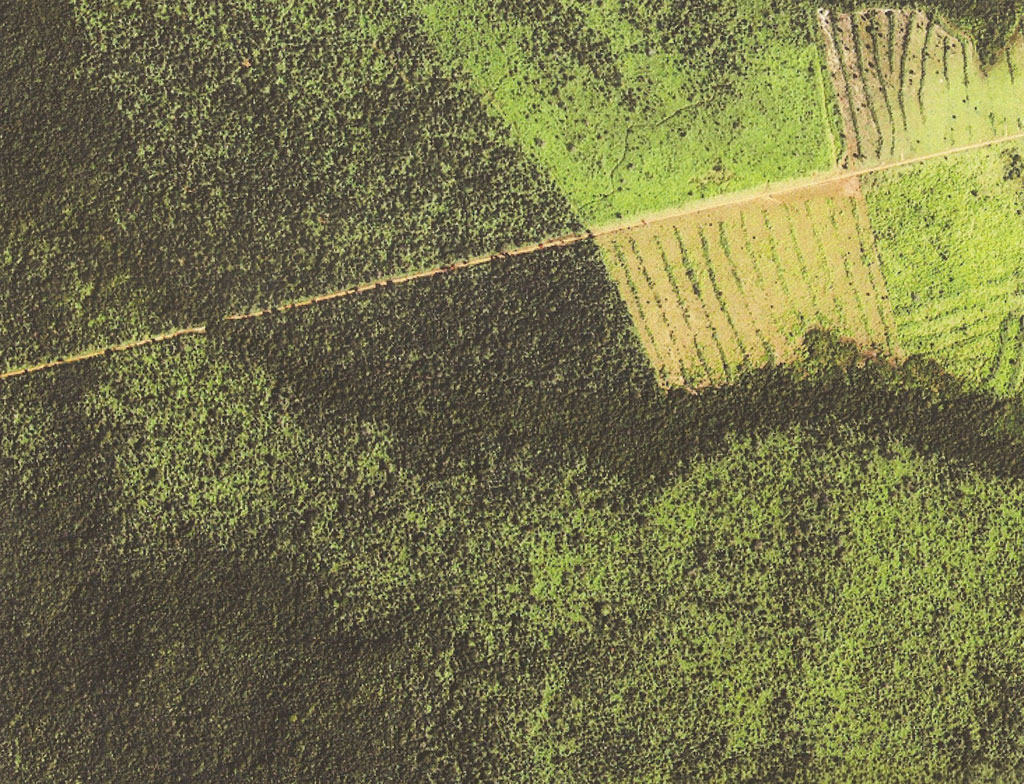
Laura Kurgan, Shade of green, Brésil, Imagery reprocessed from Geo-Eye 1m resolution, 2010
To quote this article: Cristofol, Jean, 2016, "Arts, sciences and exploratory procedures", antiAtlas Journal 01 | 2016 [Online], published on June 30th, 2016, URL : http://www.antiatlas-journal.net/01-arts-sciences-and-exploratory-procedures, DOI : http://dx.doi.org/10.23724/AAJ.8, accessed on Date
Introduction
1 “[…] I felt that I was trying to describe an unthinkable present and I actually feel that science fiction's best use today is the exploration of contemporary reality rather than any attempt to predict where we are going... The best thing you can do with science today is use it to explore the present. Earth is the alien planet now.”
William Gibson
The age-old question of the relationship between arts and sciences has taken on a new significance in recent years. It has also been profoundly transformed, enlarged, and renewed. For a long time, it remained relatively marginal, apparently confined to a fringe of artistic practices and largely ignored by the great majority of scientists, regardless of their discipline. All this happened as if it was not, in fact, a serious question for either art or science. Even if, by drawing up a long list of artists we could demonstrate the long-standing nature and wide variety of the relationship between arts and sciences, it seems to me that it was still, until recently, considered a somewhat hazardous speculation, without any real relevance to the veritable interest and quality of artworks, a form of justification for fundamentally recreational experiments, a domain for dabblers in science fiction, a playground for researchers in search of the poetic and for artists in search of recognition. One aspect of this marginalization, it seems to me, is due to our seeing this relationship as merely a question of ‘means’ or ‘techniques’. Thus, for a long time now, it is as if art could at best find models and instruments in science and as if, in art, science sought an echo, a free extension, or simply an opportunity for illustrating part of its ideas. However, this situation is changing rapidly and the relationship between arts and sciences is increasingly becoming a real issue for both artists and researchers, both in the field of artistic practices as in scientific research. Increasingly, it is seen as an important element in contemporary culture and has emerged as a dimension in political action.
For a long time now, it is as if art could at best find models and instruments in science and as if, in art, science sought an echo, a free extension, or simply an opportunity for illustrating part of its ideas.
It is therefore essential that we approach this issue from a different angle. For example, we must review the diverse forms of scientific knowledge, the growing interest in interdisciplinary approaches, and the role of human and social sciences. We must also take into account the impact of information technologies and the development of techno-sciences. We must certainly compare scientific models against economic and social crises, ecological issues, and the development of technocracies which use scientific expertise to underpin their legitimacy and which lead us to question the future of democracy in modern societies. Science is today, more than ever, challenged by issues relating to method, culture and sense.
next...
2 But, on the other hand, we must also take into account the evolution of artistic practices themselves. We have a tendency, when we think about art and in particular about plastic or visual art, to refer to traditional forms such as painting, sculpture, drawing, and other disciplines linked to them. However, since the 19th century, with the arrival of photography, and more and more widely during the 20th century, cinema, video, and finally with the development of digital technologies, artistic practices have diversified considerably. They now use technological mediums and have to take into account the world of machines. It is the form of these artistic practices that have changed and, with them, the very idea of what we call ‘art’. In the 1920s, these transformations and their consequences were already being discussed by artists such as Moholy-Nagy (1993) or by philosophers such as Paul Valéry (1928).
These men clearly understood that such transformations were not due merely to the emergence of new resources that replaced earlier practices or even of new artistic mediums that complemented traditional mediums. It would be fairer to say that they upset the relationship between artistic practices and the social and economic environment in which that relationship exists. In the traditional practice of art, such as painting, the medium is naturally a constituent element, whereas, with digital artistic forms, and this in part is what defines them, technique is no longer just a medium for artistic practices. Already, photography is no longer a medium restricted to artists; it is now available to everyone. It acts as the technical and industrial vector for a wide range of different scientific, journalistic, familial and artistic activities. This is one reason why it makes no sense to say that photography is an art: simply put, it is no longer the photographic medium that defines the artist’s practice; rather it is the artist who uses photography as a medium for his artistic practice. And it is for this reason that Benjamin (Benjamin, 1931/2012) replaces the question of whether photography is an art or not, with that of how art has evolved in the photographic era.
next...
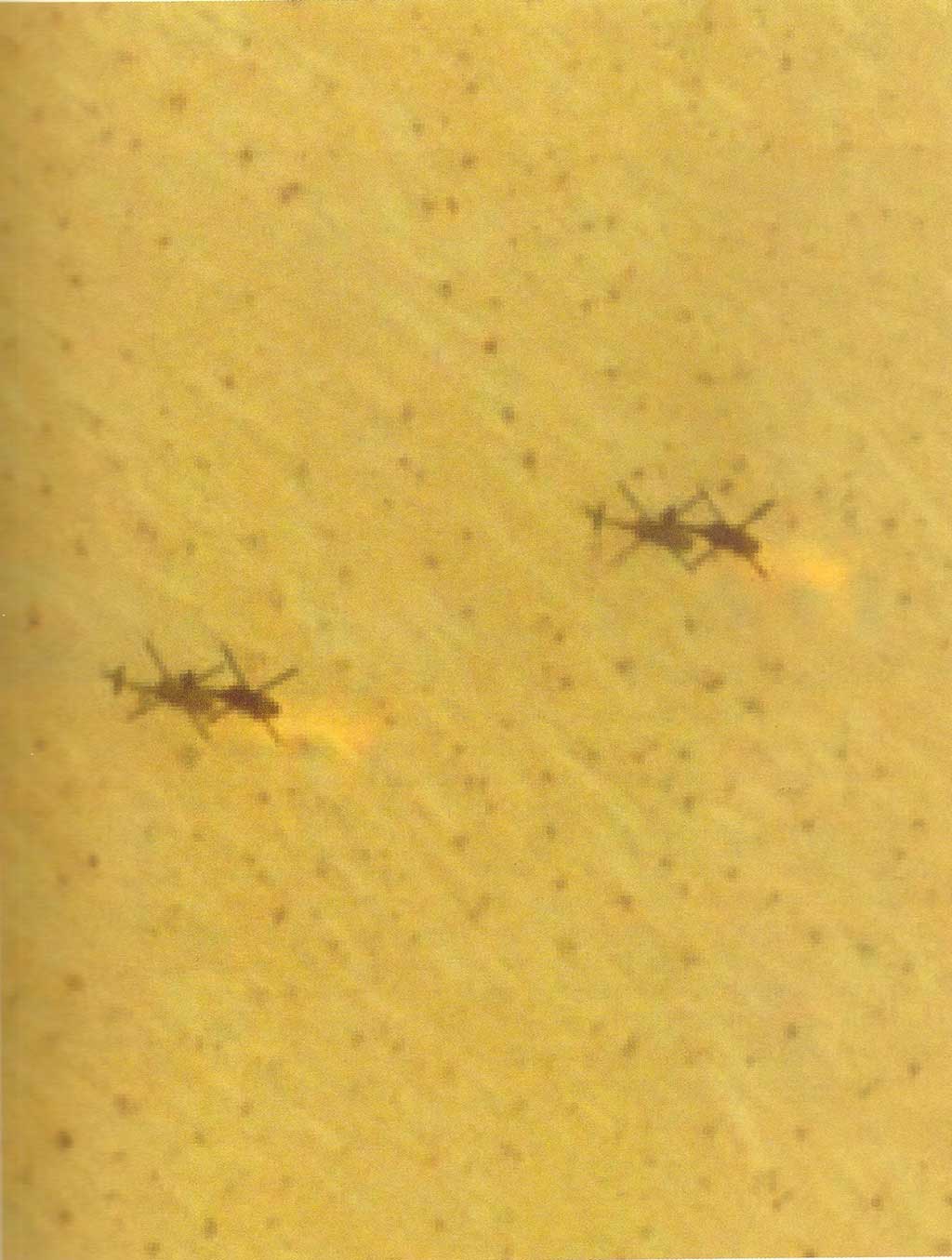
Laura Kurgan, Yellow southern desert southeastern Iraq,
between Al Busayyah abd An Nasiriyyah, zoom3, 2003
3 Digital technologies have radically generalized and extended this evolution, because they are no longer mediums, or even a specific medium: they are available to everyone in today’s society. They penetrate, traverse, and cause mutations in the entire range of practices: conception, communication, and production. Artists using digital technologies are no longer restricted to using just one medium for their art, they are now totally involved in the field where the relationship between knowledge and action occurs (Cristofol, 2005). Diversification and transversality of contemporary artistic practices, whether using digital technologies or not, cannot occur unless the fundamental character of these upheavals is taken into account because they touch the very medium in which culture is articulated. For example, they modify the relationship linking the domains of industry, science and culture. The artist is no longer limited to his craft and savoir-faire as if they establish a territory from which he looks out at the world. He now finds himself in a quicksand where the production of forms, discourses and situations challenges the way that a point of view, a place, or an experience are defined, for each individual, by technological, scientific social and cultural issues.
In addition, it is not just a question of asking about the role that sciences can play in art, or in the composition and structuring of artwork, or in the cultural environment that nurtures art and determines its content. Rather, we must look again at artistic practices as part of an entire range of social practices. We must take into account the displacements that modify relationships between domains that our concept of culture has placed into separate spaces. By art, we are not referring just to the private sphere, or the intimate exercise of improving one’s spirit, or an education in taste. Art can no longer be confined in a world that is separate from the social domain of industrial production, the theoretical domain of knowledge production, or indeed the public domain of political action. Art focuses on a social space in which the whole range of traditionally different domains seems to displace and go beyond those limits. Market valorization has now been established in areas such as lifestyle, social aesthetics, the symbolic interplay of brands, and storytelling (Rifkin, 2005). Knowledge and innovation lie at the heart of what we call the knowledge economy. Politics closely interacts with the media, and strategies of obtaining acceptance of administrative and technocratic decisions by citizens have largely escaped all forms of democratic control (Salomon, 2007).
The place of art in society has changed, as have its function and relationship with cultural forms developing in the various media
More specifically, the place of art in society has changed, as have its function and relationship with cultural forms developing in the various media (e.g. advertising, communications, and entertainment). This does not mean that art, or artistic practices, has integrated or seeks to integrate the domains of communication, entertainment, publicity and politics, or indeed the production of scientific discourse. However, it is essential that we defend the specificity of approaches that are not produced with the same intentions, do not use the same rules, and do not focus the same issues. On the contrary, artistic practices must take into account these other realities. They initiate our experience of an environment that has been profoundly transformed, technized, and mediatized. This supposes that art cannot be reduced to the subjective expression of sensibility, or to the creation of a form that is destined to be judged merely on its aesthetics: it supposes that art has a particular relationship with knowledge and with the production of sense. The objective for this short essay is indeed to review the idea, which is after all quite banal, of what I would call the exploratory character of artistic practices.
next...
I. The notion of exploration:
the example of Moholy-Nagy
4 Art as a modality of experience is an idea put forward by the American philosopher, John Dewey (Dewey, 2010) in 1934. His hypothesis is very clearly seen as part of a process solidly based on the reality of artistic practices in his time. It is interesting, for example, to compare his reflections with the very innovative theoretical proposals put forward by an artist such as Moholy-Nagy in the mid-1920s, some ten years earlier (Moholy-Nagy, 1993). At that time, classical philosophy saw aesthetics as the foundation for the spectator’s experience of art, essentially as an outcome, a ‘finished’ product complete in itself, but it now sees art as a way of linking artistic practices to a series of procedures, approaches and developments that not only produce object-artworks, but act on our environment and our perception of that environment. We now understand that art offers an opportunity to challenge our experience of the world around us. This supposes that the forms and means of art are transformed at the same time as society is itself transformed. This is not just a cultural transformation. It does not focus only on ways of living, thinking, and perceiving. It also implies a relationship with the material conditions of existence, perception, and knowledge. This is how Moholy-Nagy saw, in industry and communications technologies, the power that has totally modernized the world in which we live and realized that art offers a privileged position from which to explore the potential generated by these transformations.
Machines have become machines to watch and listen; they extend, empower, and multiply our senses
What does this notion of exploration mean exactly? We usually attribute to art an aesthetic (formal) function and a representational (mimetic) function. The notion of exploration does not refer entirely to one or the other. For Moholy-Nagy, for example, it represents the desire to take into account how the industrial society, as it developed during the early 20th century, transformed not only social relationships, but also perceptions of reality. On the one hand, mechanisation of production, spread of urbanization, standardization of merchandise, and the revolution of means of transport and of communication have led to the emergence of societies in which “the masses” play a decisive role. Thus art can no longer be seen as a single model for inter-individual relations, nor as the privilege of a cultivated minority. Emerging cultural industries open up horizons for the collective imagination that no one had previously imagined, and their impact on behaviour will reveal a complex terrain of influence, or indeed of manipulation (Bernays, 2007). On the other hand, the capacity of machines and appliances for recording and diffusing images and sounds has profoundly modified the way that we see, hear and communicate. In 1925, Moholy-Nagy wrote:
“A hundred years of photography and two decades of film has extraordinarily enriched us and we can indeed say that we see the world with quite different eyes” (Moholy-Nagy, 1993).
Machines have become machines to watch and listen; they extend, empower, and multiply our senses. The cinematographic montage, the photographic collage have developed into forms of writing and composition that generate new ways of playing with space and time, similar to the speed of trains, cars and aeroplanes.
Our appreciation of art is no longer limited to being in the presence of a unique artwork or to attending a programmed event: with the many formats for reproducing and distributing image and sound from anywhere and, increasingly, at any time.
next...
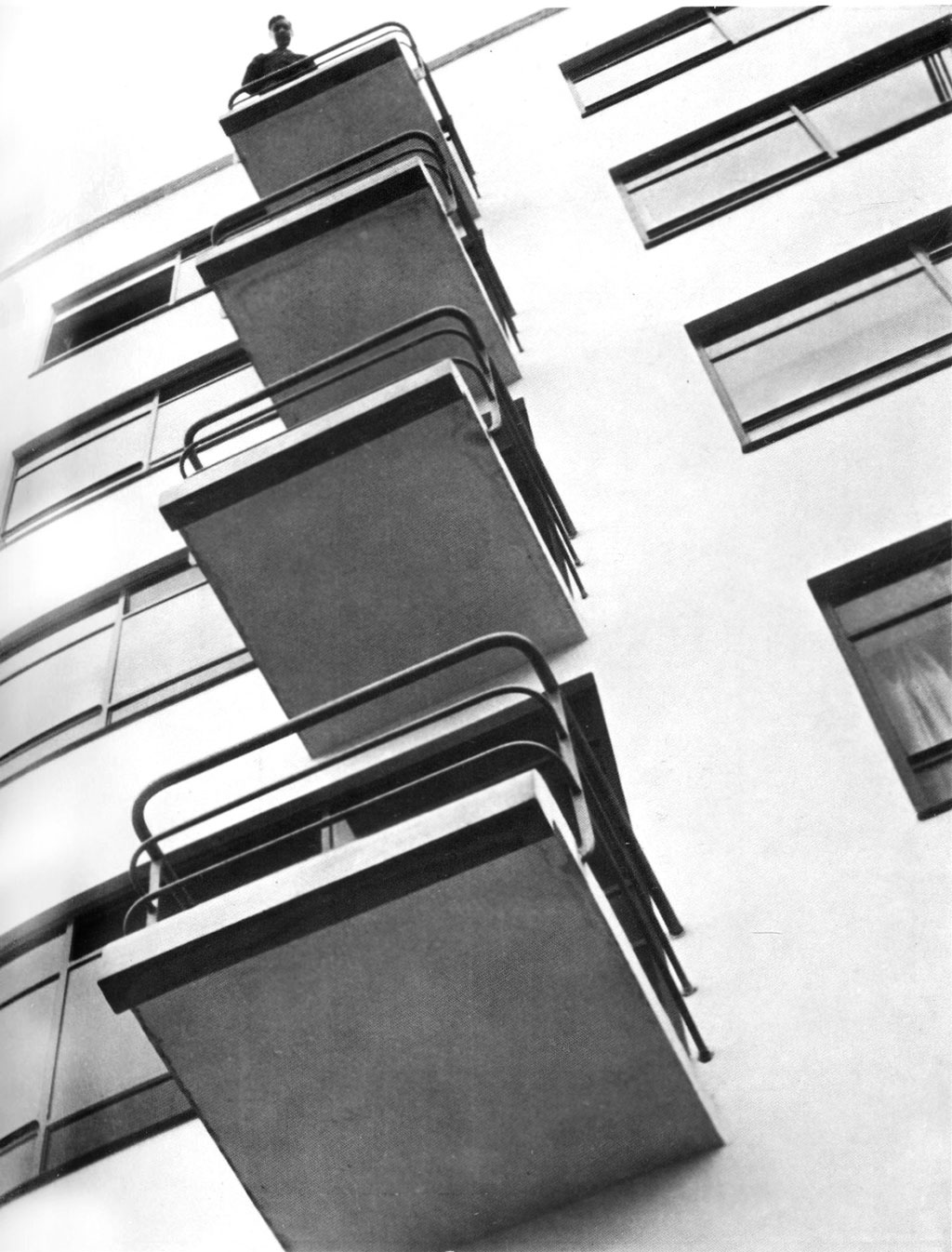
László Moholy-Nagy, Bauhaus Balconies, 1926
5 Our task is, on the one hand, to play on the new relationships between art and daily life and, on the other, to test the possibilities for perception offered by this extension and empowerment of our faculties, what Moholy-Nagy calls our “functional appliances” which are both our natural organs and the technical prosthetics that extend and transform them. The principle that separates art from other approaches is the free invention of new relationships (auditory, optical, narrative) that make use of resources generated by industry for opening up new opportunities for creation and combatting the tendency to repetition, the banalization of daily life, and the homogenization of behaviour. The idea of an opposition between the mechanisms for repeating, standardizing and recognizing conventional forms and values and the desire for the emancipation of humanity with access to more and more knowledge, the ability to live previously impossible experiences and participate actively in society are described by a wide range of authors in the early 20th century. There is a clash between reproduction of the same and production of the new, conditioning of behaviour and desire and conquest of liberty that modifies the way we feel, live and think.
“Production (productive creation) serving, in the first instance, the human constitution, we must attempt to exploit, for productive purposes, the apparatus (means) that until now has been used only for reproductive purposes.” (Moholy-Nagy, 1993)
Moholy-Nagy places artistic practices in a broader aesthetic context which takes into account the experience as a field of exploration.
Art is thus perceived as the practice that allows a qualitative transformation of the individual’s relationship of individuals to the environment and the emergence of new types of perceptive and cognitive experiences. Or more exactly, art is the place in which sensitive potential in a world undergoing total transformation can be tested. This involves bringing forth sensitive and poetic events which, until now, were thought to be impossible or unimaginable. This involves the generation of new possibilities for experience. Moholy-Nagy writes:
“The constitution of man is the synthesis of all his functional appliances, and he is at the height of his perfection at the moment when those appliances – from cells to the most complex organs – are perfected and intentionally raised to the limit of their capacities. Art is the agent for this perfection which is in fact one of its most important functions. On the perfection of the organ of perception depends all the efficacy of its attempts to establish and impose on these functional appliances in new and fertile relationships between known phenomena (optic, acoustic or other organs) and other – as yet unknown – phenomena. Man has this in particular: that his functional appliances are never saturated. On the contrary, every new sensation provokes in him the desire to receive other impressions. Fundamentally, this explains the necessity that man feels for permanently renewing his creative experiences. Thus, creations are only beneficial on condition that they can produce as yet unknown relationships. By this, I mean that reproduction (i.e. the repetition of existing relationships) in art can only be seen, in the best of circumstances and specifically from the perspective of creation, as an exercise in virtuosity” (Moholy-Nagy, 1993)
Moholy-Nagy places artistic practices in a broader aesthetic context which takes into account the experience as a field of exploration. He does not see this experience as abstract or primal because it is historically, socially and technologically determined. Nevertheless, it cannot be reduced to the refined universe of the cultivated elite: it is inseparable from the reality of human existence. More broadly still, it creates a link in the relationship between a living organism and its technically transformed environment. But it is indeed because these relationships are produced and because they can be worked, developed, enriched, and continually renewed and reinvented that it becomes a question of art and of artistic practices.
next...
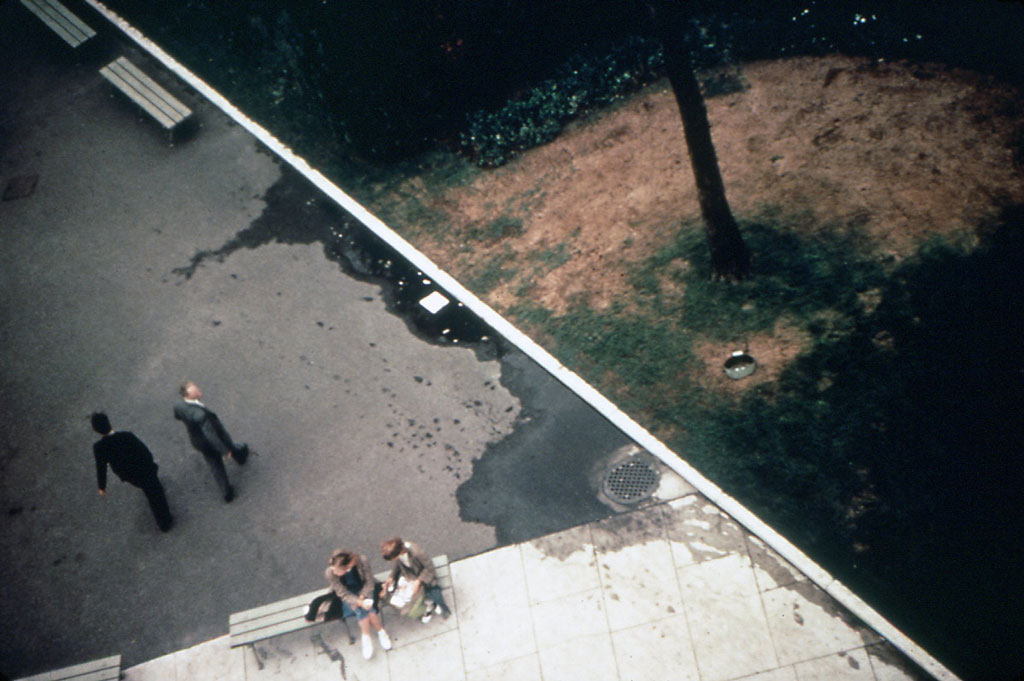
László Moholy-Nagy, untitled, 1940
II. Vilèm Flusser,
the apparatus and the programme
6 This exploratory dimension is certainly not just the product of early 20th century avant-garde. On the contrary, I will put forward the hypothesis that we can find it in very different contexts and in very different forms, without feeling that it has, in any way, lost its sense or basis. This is, for example, the position taken by Vilèm Flusser in the 1980s, as published in his persuasive essay on photography (Flusser, 1996). This example interests me for two reasons. First, because it covers the relationship with the technique and because it demonstrates that it is not just a question of means, but that techniques and technologies open up specific fields of research. Second, because it introduces the question of form and formalism, but in a way that is both original and enlightening.
One of the principal ideas developed by Flusser demonstrates that cameras, and all other appliances produced by technology, are not just technical material appliances or functional objects, but also systems corresponding to a programme they were designed to achieve.
One of the principal ideas developed by Flusser in this text demonstrates that cameras, and all other appliances produced by technology, are not just technical material appliances or functional objects, but also systems corresponding to a programme they were designed to achieve. In some ways, the photographic appliance and the practice for which it is needed represent, for Flusser, the first manifestation of a new type of appliance. These are technical objects which are not used up in their immediate reality, but which continue to exist as something else, the programme, for which they are a necessarily relative, temporary and limited manifestation. This supposes first a distance or incompleteness between the appliance and the programme which, inevitably, extends beyond it. Meanwhile, the programme opens up new possibilities which, in turn, go beyond its simple and formal description, in the same way as they go beyond the necessarily limited intention of the person who designed and produced it.
We will recall that Walter Benjamin, in a famous passage in A Short History of Photography, described how Arago, in his presentation of Daguerre’s invention to the National Assembly in 1839, did not merely justify its existence with regard to painting, but reviewed the diversity of opportunities that it offered and the immense range of consequences it would have on human activities. This led him to reflect on the issues raised by inventions and on the very essence of invention, which does not consist merely of producing a new appliance, but also of seeing this novelty give birth to developments that will surpass those previously imagined. Benjamin quoted Arago:
“When observers use a new instrument for studying nature, what they hoped to obtain was always much less than the series of discoveries that the instrument would generate” (Benjamin, 1931/2012).
The idea is to ascertain the distance between the inventor’s intention and the invention’s potential, to show that there is, in the invention, much more than its designer could have imagined. Flusser’s proposal goes even further. It challenges the very structure of technologies in their relationship with scientific models. To all intents and purposes, it positions, in time, a process that will later undergo an immensely wider development following the emergence of Alan Turing’s idea of an abstract machine (1936) and, more generally, the now trivial distinction between hardware and software. Furthermore, it poses the question of a specificity in the artist’s relationship not only with the appliance, but also with the disparities that occur between the appliance and the programme, the uses foreseen and the possibilities to be invented (or revealed), and the games of inventive imagination and the strictly instrumental vision of a utilitarian conception of techniques and knowledge.
next...
7 Only the users and the use they make of appliances can reveal and fulfil the potential generated by programmes. But it is still necessary to avoid reducing these uses to a pre-defined application for conventional purposes. This is why Flusser affirms that the artist has a relationship not only with what is real, but also with the range of possibilities provided by experimentation with appliances. It is up to the photographer to create new images and new relationships with images, develop unexpected images, and deflect and perturb unsaturated functionalities. The artist’s objective is to use the entire scope of the programme. Flusser wrote:
“The possibilities offered by the appliance’s programme are practically inexhaustible. It is impossible to photograph everything that can be photographed. The appliance’s imagination is greater than that of any individual photographer, or indeed of all photographers; this is in fact the challenge the photographer faces … What the photographer, as we understand his role here, seeks in the appliance’s programme are still undiscovered possibilities, informative, improbable, never-before-seen images.” (Flusser, 1996)
Art is a space for simultaneously interrogating and exploring ‘appliances’
What Flusser says about the technological production of images can be extended to the much larger field of technologies that artists are continually taking up, including robotics and bio-technologies. If Moholy-Nagy suggested that we see artistic practices as a way of revealing the potential offered by the material transformation of both our environment and our faculties for perception and for action, Flusser has shown that art is a space for simultaneously interrogating and exploring ‘appliances’, regardless of their form, once we consider them as systems corresponding to a programme. This explains why artists immediately became involved in digital technologies as users and as actors and explorers.
next....
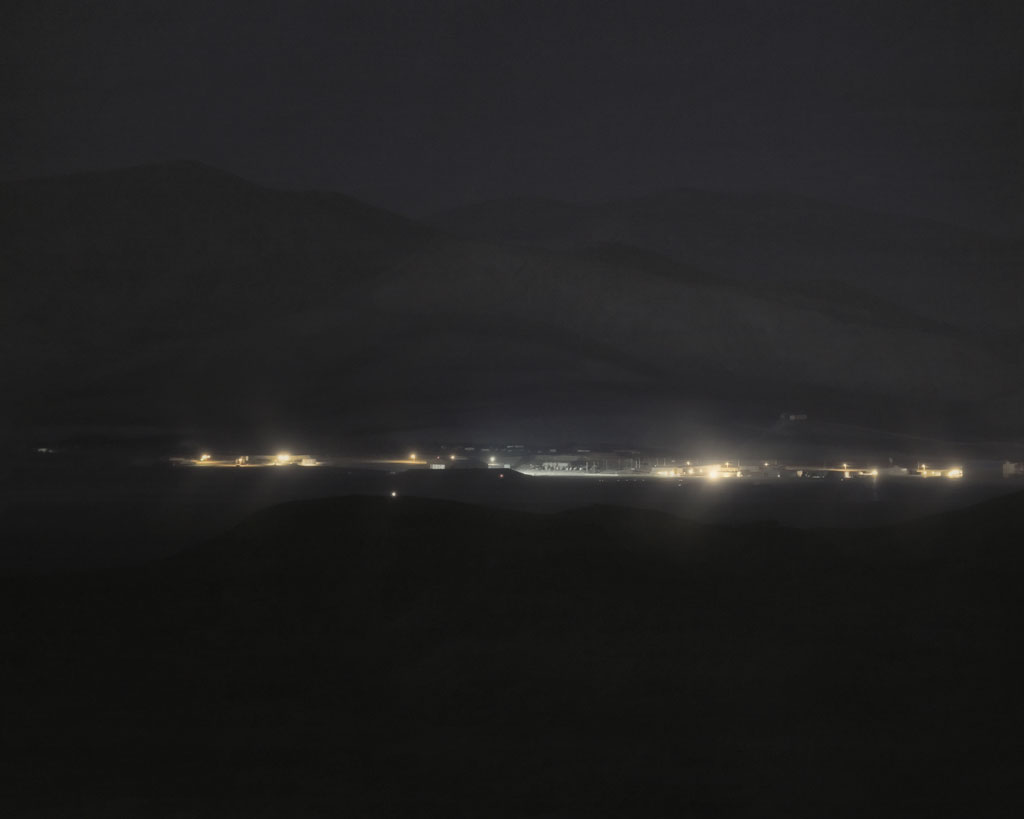
Trevor Paglen, Detachment 3, Air Force Flight Test Center #2Groom Lake, NVDistance ~ 26 Miles, 2008
III. Concrete space as a field of experience
8 Yet another way to approach this reflection on the exploratory nature of artistic practices is without doubt linked to fields in which these practices are developed and which determine a whole range of relationships for arts, sciences and techniques. This is the case for sound practices and music, for example. It is also the case, though in a quite different way, of artistic practices in concrete space. It must be noted, however, that these categories are relative and do not constitute domains that are by nature separated so that they might be susceptible to developing a pertinent and adequate categorization of artistic practices, each in relationship with the other. Practices in concrete space can also be sonic practices, for example, as seen with the soundwalk or other practices using technologies of mobility, geolocation, etc. What constitutes pertinence for these ‘fields of practices’ is less the distinction between their ‘objects’, which are always complex and apt to coalesce, but rather the way they can sketch out problematic configurations in which relationships linking artistic approaches, technologies, scientific domains, and cultural and political issues are constructed. This is exactly what the research by the geographer Anne Volvey shows, in her descriptions of how spatial sciences (geography, urban development, architecture, territorial development) converge in the approaches taken by artists who interrogate and construct contemporary forms of spatiality, a dynamic that is both critical and constructive and contributes to a redefinition of the field of their own constructions of knowledge and action.
Involuntary parks and cyberspace
“What is at stake here”, she wrote, “is the capacity of contemporary art, as a practice (or collection of practices), to create situations that articulate a given spatiality and a given temporality around an individual or collective project through interactive and contractual procedures, situations that create conditions for opportunities for the clarification of meanings attached to places and their confrontation, in form and as objects of art-places” (Volvey, 2008).
The question of the lived, traversed, inhabited space has given rise, over several decades, to the installation of artwork in situ that vastly surpass the classic activity of representations of landscape. It is always difficult to define the sequence of elements which lead to the emergence of a historical phenomenon, and all the more so in that there was no reason to believe that this sequence must consist of a linear series of continuous events. From the perspective of the history of art, we can mention the series of practices of roaming, rambling, and walking which, since the surrealists at least and particularly the Situationists in the 1960s, we have turned the urban space into the terrain for a poetic and erudite experience (Debord, 1995). We must certainly emphasize the importance of the role of the Land-Art movement, dominated by American artists but developed mainly in Germany as a result of the division of Berlin by the wall that embodied the border with violence and a completely unexpected originality (Semin, 2015). We can even imagine that cyberpunk literature, which invents both Bruce Sterling’s ‘involuntary parks’ (Sterling, 1998) and William Gibson’s Cyberspace (Gibson, 1985), plays an important role in this process and constitutes one of its manifestations. In addition to these elements, there are relationships that are increasingly nurtured between art and cartography, the deep transformation of our rapport with the map through the multiplication of intersections between real and virtual space, and the possibilities opened up by systems of geolocation and mobility technologies. The question of borders, with all that they mobilize in terms of complexity, all the imagery they portray, the relationship with territory that they crystallize, all that they reveal of strategies of surveillance and control systems, all that they generate in political and social issues – migratory flows, for example – constitutes in this context an element of polarization and a critical point.
next...
9 This overlap of preoccupations, which developed in multiple ways and forms, seems to me to bear witness to a fundamental reality, that of the transformation of our relationship to concrete space, to the modalities of its production, organization, uses, and the way in which it determines our existence, status, identities and representations. We were living in a world that was deployed in a relatively homogeneous and coherent space, commanded by symbolically and aesthetically structural oppositions of what is near and what is far, what is inside and what is outside, what is within and what is without the limits (urbanistic, sociological, political, cultural) that structure it. This world has disappeared, giving way to a much more complex reality, made up of combinations that can no longer be superposed, but which constitute so many interlocking spheres. A reality in which distance rushes out at the street corner, while sameness is disseminated everywhere on the planet, in which economics wipes out borders, while walls are built to prevent people for travelling, and in which drones make it possible to target individuals at thousands of kilometres’ distance in states where war has not been declared. What was, or seemed to be, obvious, the spatial order against which the horizon of our existence is drawn seems to escape from the possibility of a unified and coherent appropriation and from the laws of common sense which seemed to us to be intangible. What seemed to us to be a given now appears, clearly, as a construction, the product of our operations. The role of technology is obviously determinant in these transformations, because our spatial relationships are inevitably a construction of mediations, and that mediations are inseparable from concrete appliances and systems in which we galvanise our movements, habitats, actions and productions, communications and exchanges.
It is no longer a question, for many artists, of representing what is given to us, but of revealing, working, experimenting what is currently being produced.
It is no longer a question, for many artists, of representing what is given to us, but of revealing, working, experimenting what is currently being produced. Space is no longer that which opens up before us, but which is articulated by our gestures and our appliances. We are no longer in front, but to a certain extent inside, and we must rediscover what it means to perceive and locate ourselves. This reality is only manifested because it is solicited, activated or submitted.
next...
IV. Trevor Paglen
and the experimental geography
10 Here we see a terrain in which the ancient relationship between theory and practice is redistributed. Much time has passed since art incorporated critique into its practices. And it is not new for artists to become theoreticians and scientists, creating a game of echoes and contaminations between these two dimensions of their work. I am referring, for example, to the writer-mathematicians of OULIPO. But even in this case, and despite all the connections one would like to make, the two activities remained not only quite distinct, but also well anchored in their respective disciplinary fields. It seems to me that there are other constructions demonstrating how artists see their practices as heuristic processes.
For example, Trevor Paglen proposes, when speaking about his work, the concept of ‘experimental geography’. As an artist, Trevor Paglen is particularly well known for his work of investigation, surveying and identification which takes him out of the library and into the desert areas of the United States. He is now working on the relationship between the visible and the invisible, in the way representation creates through interplay and omissions, methods and evasions. In his texts, photographs and videos, he seeks to reveal secret installations sheltered in inaccessible areas, he records the disappearance of people organized by American intelligence agencies and the networks they use and questions the way in which space is constructed and how it displays the state of our world. He said:
“the theme that I develop is not, contrary to what one might often think, the revelation of secrets, but the political epistemology.”
Paglen’s work is part of the context of new developments in geography and cartography, and in particular the way in which maps, and more generally digital technologies of representation and treatment of space such as GPS, have seen their use extended from the more sophisticated usage to the most banal aspects of daily life. These changes have contributed to the establishment of a totally new relationship with space and technologies of its representation, they have radically broadened and blurred the horizon of the visible, they have opened up new areas of intervention of all sorts of actors and new possibilities for the collective imaginary.
From the historical perspective, we can readily emphasize the links bringing together cartography and the strategic interests of powerful organizations, whether military or economic, in every period and thus their implications for scientific and ideological issues. Geographical representation is traditionally marked by the particular aspect of maps that closely expresses theoretical knowledge and perspectives for action. This has contributed to the development of a critical approach that shows how much representation of space is inseparable from the material process of its production. It also shows how the production of concrete space is inseparable from production of a certain type of perspective. The ways of seeing and representing accompany the formation of a spatiality that determines the position of subjects, their reciprocal relationships, the rules for distribution and occupation of territories, the reasons for displacement, control and discrimination, the issues involved in the ability to travel and the obstacles that forbid it. As Trevor Paglen has written:
Cultural production and the production of space cannot be separated from each another.
“Experimental geography refers to practices that take on the production of space in a self-reflexive way, practices that recognize how cultural production and the production of space cannot be separated from each another, and that cultural and intellectual production is a spatial practice. Moreover, experimental geography means not only seeing the production of space as an ontological condition, but actively experimenting with the production of space as an integral part of one’s own practice. If human activities are inextricably spatial, then new forms of freedom and democracy can only emerge in dialectical relation to the production of new spaces” (Paglen, 2009).
suite...
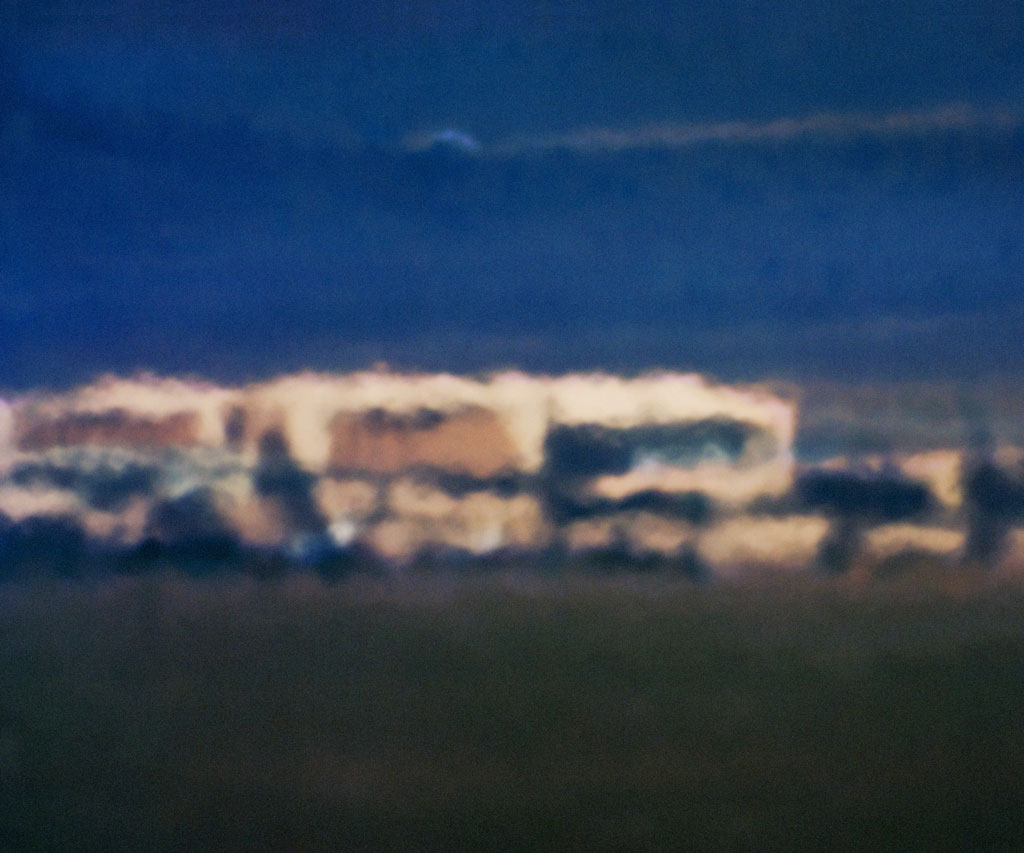
Trevor Paglen, Open Hangar; Cactus Flats, NV; Distance ~ 18 miles; 10:04 a.m., 2007
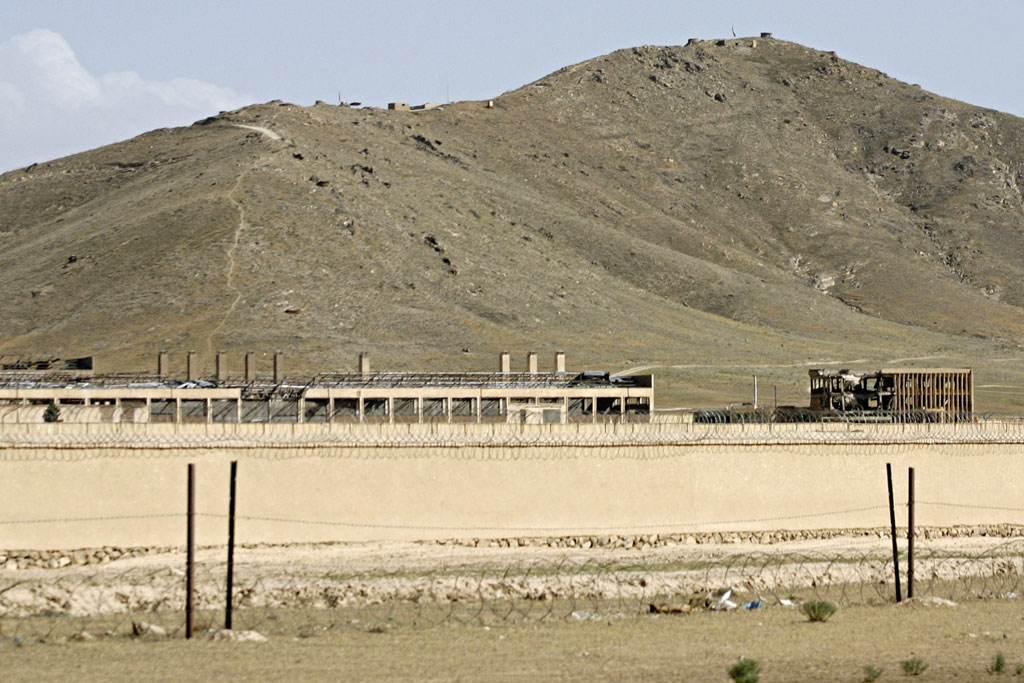
Trevor Paglen, The Salt Pit, Northeast of Kabul, Afghanistan, 2006
Courtesy of the Artist, Altman Siegel, San Francisco and Metro Pictures
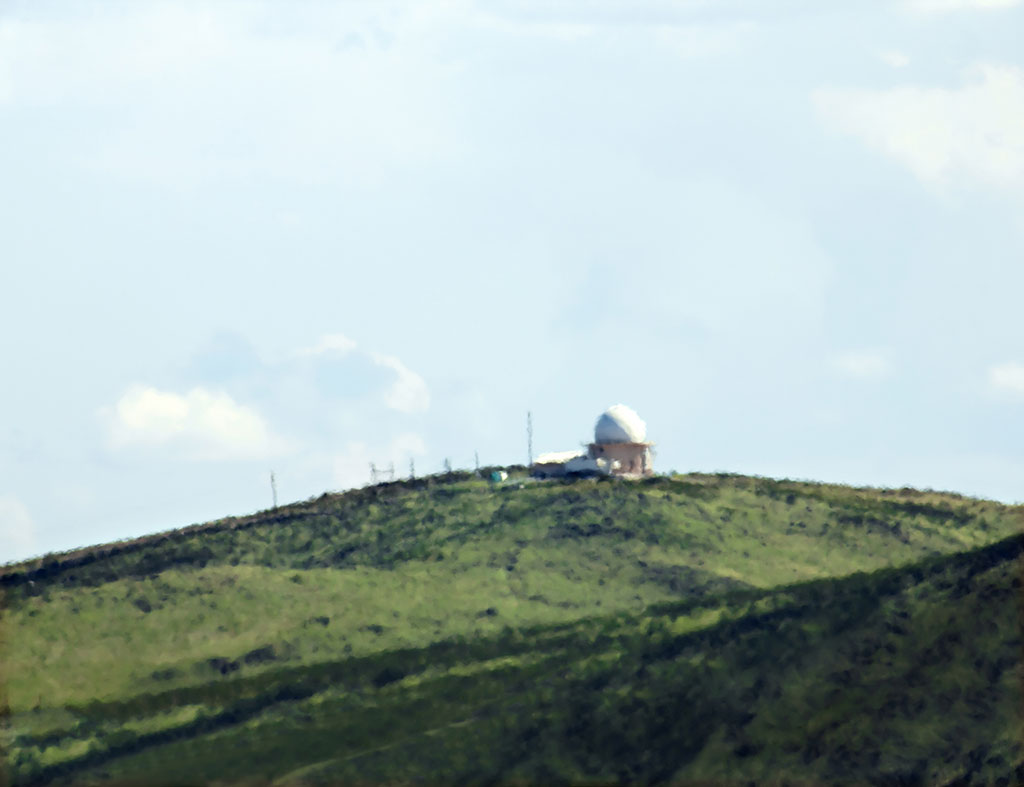
Trevor Paglen, National Reconnaissance Office Ground Services Station (ADF-SW)
Jornada del Muerto, New Mexico: Distance approx. 16 Miles, 2012
V. Laura Kurgan
and the place of the subject
11 This point of view is not so very different from ideas expressed by the artist and designer Laura Kurgan in a very beautiful book she published recently under the revealing title of Close Up at a Distance (Kurgan, 2013). The first chapter is clearly methodological or, to be more precise, offers a reflection on the historical and technological conditions that underlie and orient the approach that she has developed over more than twenty years. It is appropriate, therefore, to cite a long section here:
“Since the early 1990s — since the first Gulf War, to be precise — I have been thinking about and working with new technologies of location, remote sensing, and mapping. I understand this work as a form of research conducted through practice. The propositions and claims I offer here, however theoretical they are, only emerge for me through the process of experimenting with the technologies themselves, working with and through them to create images. That research has not simply been aimed at developing a theoretical framework for better understanding these new sorts of spatial representations, but has taken the form of a series of projects utilizing the technologies that have produced these images in order to investigate them. That work is presented here in terms of a series of projects that have formed the basis of my inquiry. They both exemplify the approach to understanding digital images articulated here and, I hope, suggest further lines of exploration.” (Kurgan, 2013)
A form of research conducted through practice
Laura Kurgan’s concept is particularly interesting, in particular because she very clearly articulates the notion of exploration through practice. The exploratory nature implies a commitment to a practice, to processes for producing an effect of knowledge. It is no longer a question of seeing the relationship between theory and practice as the experimental approach used in science, or as a two-way interaction between theory and practice, as in the Marxist tradition. As she has so aptly suggested, this is “research conducted through practice”. Practice is not articulated with theory, as one term compared to another, but it offers an opportunity for a particular approach to research and this obviously has theoretical issues. This is not to say that practice nurtures and enriches theory, it is neither a touchstone, nor a form of control, nor a way of falsifying the theory. It is a space for the development of heuristic approaches and critical effects.
next...
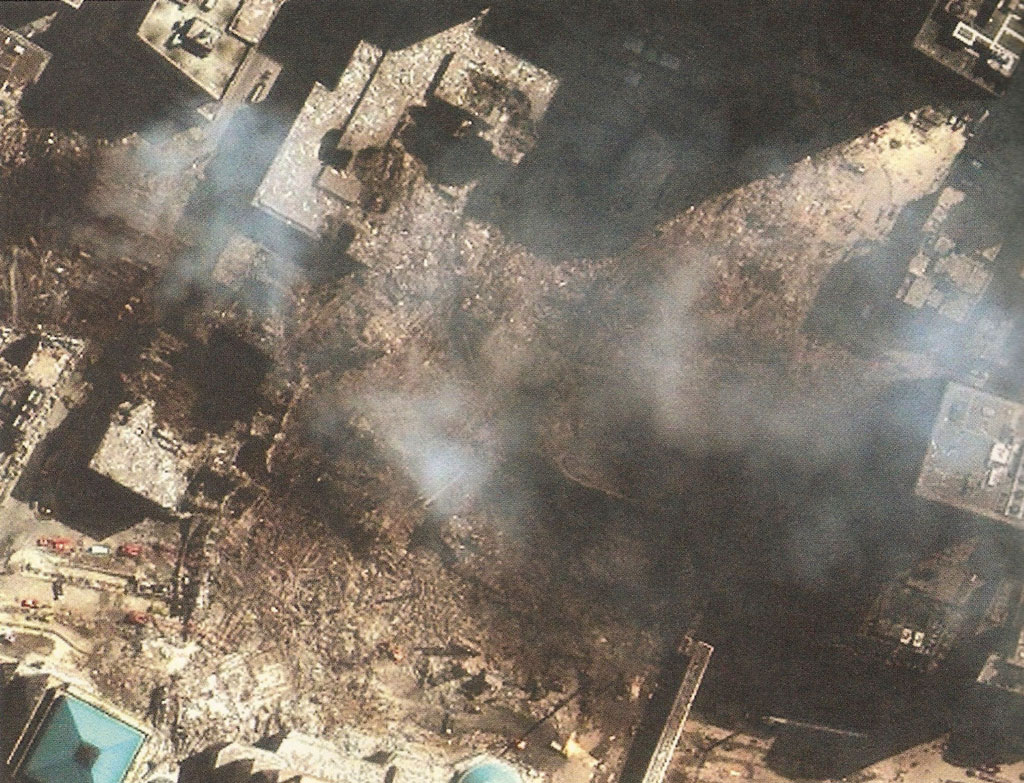
Laura Kurgan, New York, September 11, 2001, Four Days Later, World Trade Center site as seen by Ikonos satellite, 2001
12 Yet, this reflection on the relationship between practice and theory can be extended to another observation: that technologies of distance data input and location, remote sensing, and mapping place each one of us and transform the essence of our relationship with concrete space and its representation. We are no longer in front of the map, as an external document, but we are situated, defined and included in the map itself. Korzybski’s famous statement, “a map is not the territory” (Korzybski, 2001), must be re-examined in order to understand a cognitive context in which the map has become an active part of the territory, a world where we move around inside the map at the same time as we move around inside the territory. Thinking through the process by which space is produced implies that we accept the key fact that we are the stakeholders. For Laura Kurgan, this supposes that knowledge of the technologies through which these processes operate is a major issue. It also supposes that this knowledge cannot be satisfied by a theoretical hypothesis, without initiating the experience which is itself transformed. The perspective that might seek to establish the critical approach in the preamble of an exteriority is thus sent back to its own illusion. Laura Kurgan tells us:
“... We do not stand at a distance from these technologies, but are addressed by and embedded within them” (Kurgan, 2013).
A form of investigation-in-action
It is thus very clear that the artistic approach is constructed as a form of investigation-in-action, an explanation developed through the launch of specific projects, which themselves participate in clearly defined circumstances, contexts and conditions. Production takes place, but what is produced emerges as much from the artwork as from the situation. What is suggested by the artistic approach is the questioning of the existence of an experiment that does not aim to support or strengthen a theory or an explanatory model, but seeks to challenge itself, as a space open to possible interpretations. It seems to me that the exploratory character of artistic practices renews the imperative of ‘criticism’ which is, to a certain extent, consubstantial with modernity.
next...
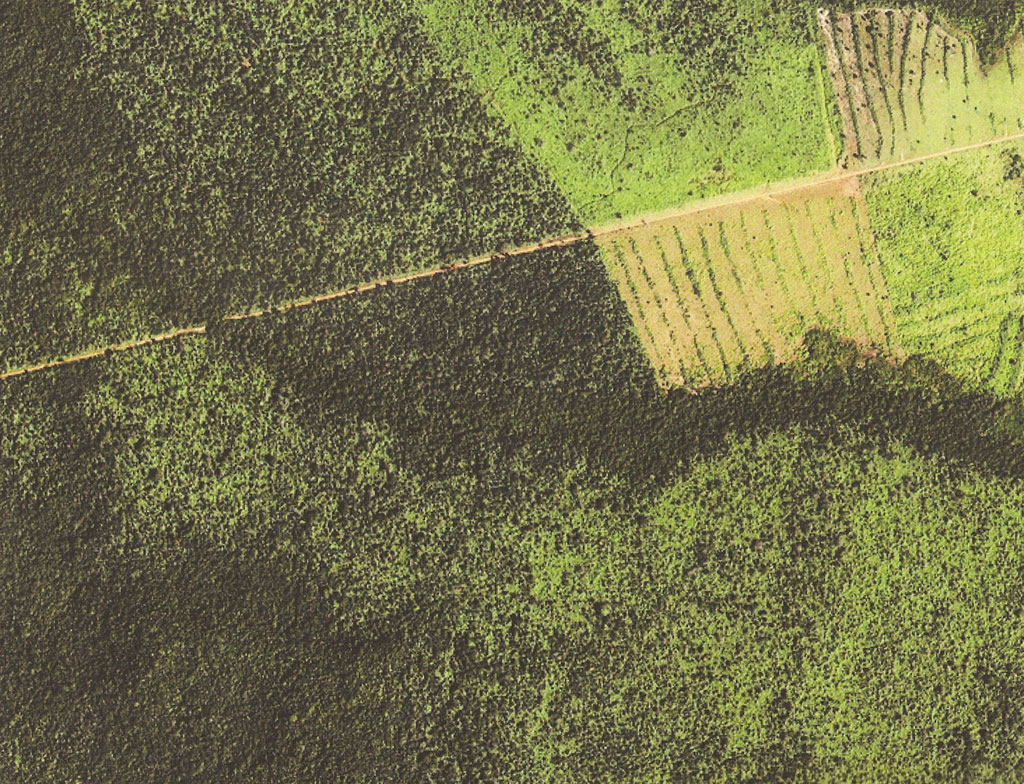
Laura Kurgan, Shade of green, Brésil, Imagery reprocessed from Geo-Eye 1m resolution, 2010
VI. For a new practice of criticism
13 We can follow this thread, criticism or the critical position in art, through these metamorphoses as a path that is deeply rooted in our history, but which became a scalpel in the hands of the avant-garde in the early 20th century. Our objective here is not to explore this thread, nor to refer back to Benjamin or to Brechtian ‘distancing’, nor to emphasize the revelatory moment when Jameson questions the very possibility of taking a critical stance to the total flow of television because there is insufficient space or time to take ‘distance’ (Jameson, 2007). in each case, the main issue is the subject and its place in the production and circulation of forms and information. But we now know that the spaces in which we are placed cannot become exterior objects, object for spectacles that are placed right in front of us. We know that our withdrawal is only, at best, a provisional stylistic device and that the way we position ourselves with regard to flows of information, for which we are always stakeholders, must be challenged and stimulated by the creation of a situation. And we know that this presentation implies that we must confront the effective configuration of these information flows, i.e. of knowledge by and through practice.
Artists and scientists are observers and actors in a shared history, even if not in the same way.
And it is indeed by its capacity to engage with this knowledge that the artistic approach cannot be in opposition to the scientific approach, that it does not turn its back on knowledge, rather it positions itself in terms of its own relationship with reality. It is a question of the place that a person occupies and the point of view that a person imposes, as ‘actor’, observer, scientist, or artist. Artists and scientists are observers and actors in a shared history, even if not in the same way. Perhaps we can amuse ourselves by saying that, while one group is preoccupied by the desire to know and understand the reality constructed by developing models which can express, as part of a movement of, say, extraction, the other group seeks to bring out the possibilities (whether positive or negative) that that reality contains, i.e. place ourselves in a relationship with this reality that involves our position as subjects with desires and knowledge, fears and hopes, within a movement we could call ‘interlinking’. In both situations, it is important to avoid economising on the complexity of what occurs, one way or another, in the experience, or as little as possible. In both situations, we know that there is a certain form of fiction that is inseparable from the process by which the experience, or its object, is constructed.
Art has the ability to make us understand of the context in which an event takes place, a tale is told and shared, or a situation is invented and tested. It encourages us to question the ‘authorized’ and a priori legitimate discourse: even if this discourse has the imprimatur of an expert, power-broker or enterprise, it has still been legitimized by an institution and, as such, it tends to reduce the experience to a predefined explanation or an implemented decision. The artistic discourse is not, in itself, legitimate, except by its own institutionalization, but even this legitimization – by the art market or academic analysis, which inevitably has its own limitations – is only relative and partial. Such discourses are fragile: they reintroduce the singularity of an implied and shared subjectivity. Our interest in artistic practices lies in their ability to challenge the emergence of new interpretations, representations, and senses. Let us repeat Victor Chklovski’s words in 1917:
“Art is created in order to demonstrate the sensation of something as a seen thing and not as a recognized thing … art is how we experience the thing being made and, in art, what has (already) been made is of no importance.” (Chklovski, 1973)
bibliography...
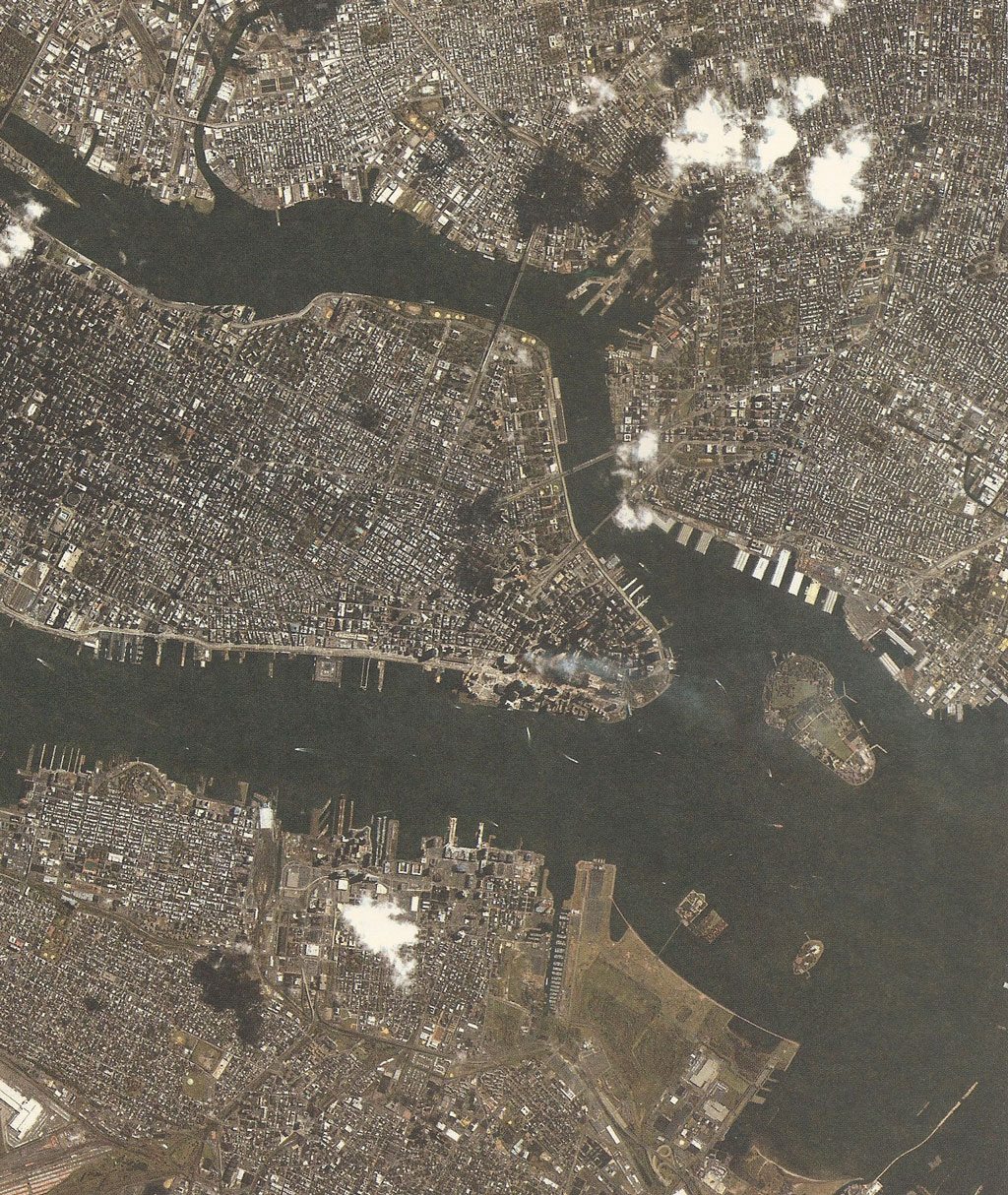
Laura Kurgan, Shade of green, 2010
Bibliography
14
Benjamin, Walter, 1931/2012, Petite Histoire de la Photographie, Paris, Éditions Allia.
Bernays, Edward, 2007, Propaganda, Paris, Éditions Zones.
Chklovski, Victor, 1973, Sur la théorie de la prose, Lausanne, Éditions L'Âge d'Homme, Traduction Guy Verret, Paris, 1973.
Cristofol, Jean, 2005, « Écritures, dispositifs et expériences », in Nouveaux médias, nouveaux langages, nouvelles écritures, Lavérune, Éditions L'Entretemps.
Dagognet, François, 1975, Une Epistémologie de l’Espace Concret : Néo-Géographie, Paris, Vrin.
Dagognet, François, 1977, Pour une Théorie Générale des Formes, Paris, Vrin.
Debord, Guy, 1955, « Introduction à une critique de la géographie urbaine », Les lèvres Nues, n°6 Bruxelles.
Déotte, Jean-Louis, 2007, Qu’est-ce qu’un appareil ? Walter Benjamin, Jean-François Lyotard, Rancière, Paris, Coll. Esthétiques.
Dewey, John, 2010, L'art comme expérience, Paris, Éditions Gallimard.
Flusser, Vilém, 1996, Pour une philosophie de la photographie, Paris, Éditions Circé.
Gibson, William, 1985, Neuromancien, Paris, La Découverte.
Huyghe, Pierre-Damien, 2006, L’art au temps des appareils, Paris, Éditions L’Harmattan.
Ginzburg, Carlo, 1998/2001, À distance, Neuf essais sur le point de vue en histoire, traduction Pierre-Antoine Fabre, Paris, NRF, Éditions Gallimard.
Jameson, Fredric, 2007, « Le surréalisme sans l’inconscient », in Le Postmodernisme ou la Logique Culturelle du Capitalisme Tardif, Paris, Éditions des Beaux-Arts de Paris.
Joy, Jérôme, et Sinclair, Peter (dir.), 2015, Locus Sonus, 10 ans d’expérimentations en art sonore, Paris, Éditions Le Mot et le Reste.
Korzybski, Alfred, 2001, Une carte n'est pas le territoire, Prolégomènes aux systèmes non-aristotéliciens et à la sémantique générale, Montréal, Éditions de l'Éclat.
Kurgan, Laura, 2013, Close Up at a Distance, Mapping, Technology, and Politics, New York, Zone Books.
Lefebvre, Henri, 1974, La production de l'espace, Paris, Anthropos.
Moholy-Nagy, Laszlo, 1993, Peinture, photographie, film, Paris, Éditions Jacqueline Chambon.
Paglen, Trevor, 2009, Experimental Geography: From Cultural Production to the Production of Space, The Brooklin Rail, http://brooklynrail.org/2009/03/express/experimental-geography-from-cultural-production-to-the-production-of-space, (dernière consultation mars 2016).
Rifkin, Jeremy, 2005, L'âge de l'accès, La nouvelle culture du capitalisme, Paris, Éditions La Découverte.
Salmon, Christian, 2007, Storytelling, La machine à fabriquer les histoires et à formater les esprits, Paris, Éditions La Découverte.
Semin, Didier, 2015, Terre balafrée (le dessin des frontières), Roven, Revue critique sur le dessin contemporain, n°11, Paris, Roven éditions.
Sterling, Bruce, 2000, Viridian Note 00023: The World is Becoming Uninsurable, Part 3.
Valery, Paul, 1928, « La conquête de l'ubiquité », Pièces sur l'art, Paris, NRF, Gallimard.
Volvey, Anne, 2008, « Land Arts, Les fabriques spatiales de l’art contemporain », Travaux de l’Institut de Géographie de Reims, n° 129-130.
notes...
Notes
15
1. William Gibson, interview with CNN, 26 August 1997, quoted in Wikipedia. URL: https://fr.wikipedia.org/wiki/William_Gibson (consulted October 2015).
2. Dziga Vertov expresses the same preoccupation. See Manifeste du ciné-oeil, 1923 (http://revuemanifeste.free.fr/numeroun/manifestedv.html).
3. This has been very clearly stated by Paul Valery (Valery, 1928).
4. Moholy-Nagy’s remarks are similar to those expressed by Victor Chklovski (Chklovski, 1973).
5. A precaution is undoubtedly necessary here. Flusser’s work has played an important role in research on appliances over twenty years or so, with contribution by authors such as Jean-Louis Déotte (Déotte, 2007) and Pierre-Damien Huyghe (Huyghe, 2006). The appliance is indeed the subject that interests me in the passage. It is not my role, however, to position myself here in terms of what may appear as a school of thought that seems to me particularly rich and interesting.
6. I refer here, for example, to the recent publication by Jérôme Joy and Peter Sinclair (Joy and Sinclair, 2015).
7. I have taken the concept of ‘concrete space’ from François Dagognet, (Dagognet, 1975, 1977).
8. See “Limit Telephotography”. For example: https://www.youtube.com/watch?v=LTb0sW13iqQ (consulted in October 2015).
9. See “Missing Persons”: http://www.paglen.com/_oldsite/pages/projects/CIA/missing_persons.html (consulted in October 2015).
10. Quoted by Stephanie Vidal, « Trevor Paglen, le secret dans tous ses états », Gaité Lyrique website, 2014.
11. Trevor Paglen quotes the text by Henri Lefebvre (Lefebvre, 1974).
12. Daniel Kaplan used this expression in 2006, quoting the sociologist Alain Gras: http://www.internetactu.net/2006/09/01/la-carte-fait-le-territoire (consulted in October 2015).
15. « ...We do not stand at a distance from these technologies, but are addressed by and embedded within them ».
http://www.antiatlas-journal.net/pdf/01-Cristofol-arts-sciences-and-exploratory-procedures.pdf


